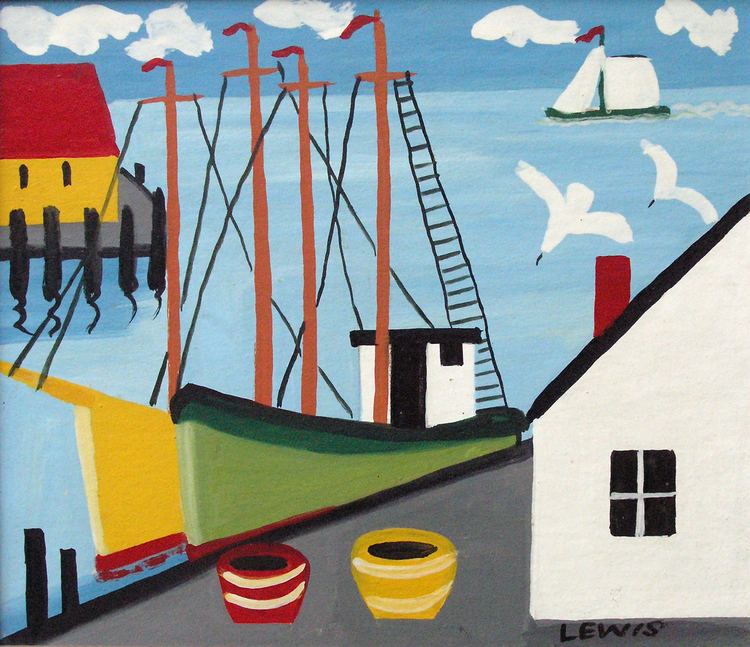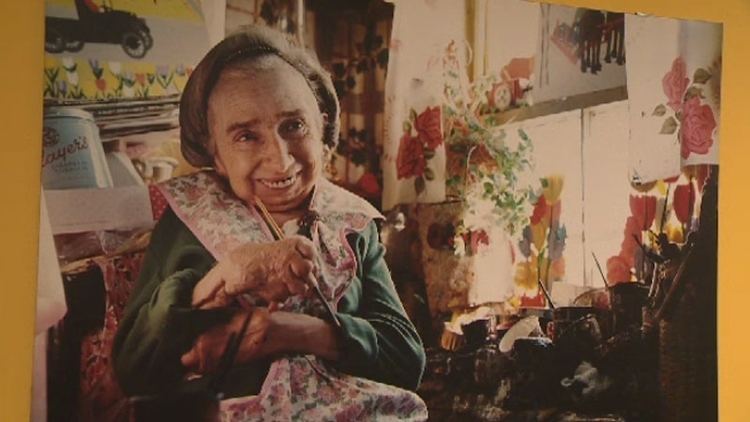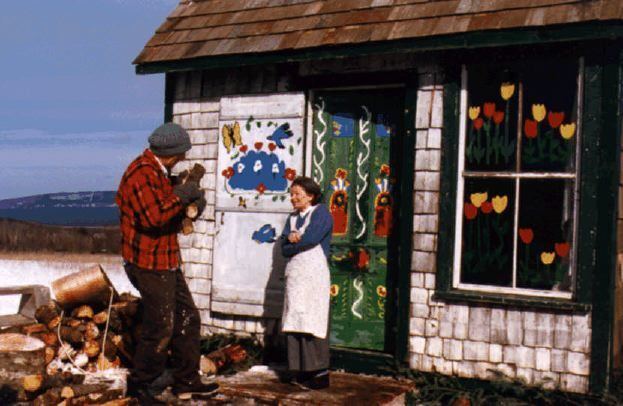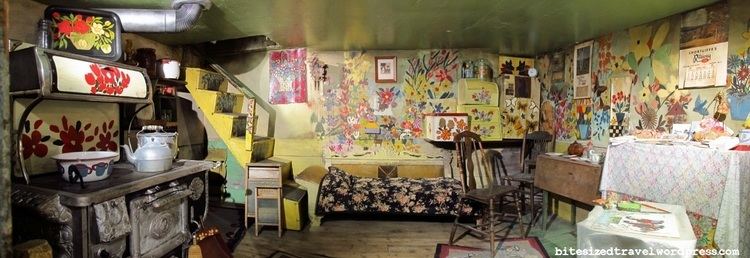Name Maud Lewis | Role Artist | |
 | ||
Died July 30, 1970, Digby, Canada Artwork Three Black Cats, Hauling Logs, World Without Shadows Similar Mary Pratt (painter) , Kathleen Munn , Robert Bateman (painter) | ||
Maud lewis painted house
Maud Lewis (March 7, 1903 – July 30, 1970) was a Canadian folk artist from Nova Scotia. She remains one of Canada's best known folk artists.
Contents
- Maud lewis painted house
- Maud lewis a world without shadows
- Early life
- Marriage
- Paintings
- Later life and death
- Maud Lewis House
- References

Maud lewis a world without shadows
Early life

Lewis was born Maud Dowley on March 7, 1903 in South Ohio, Nova Scotia, the daughter of John and Agnes (Germain) Dowley. She suffered from a result of juvenile rheumatoid arthritis. In 1935, her father died and in 1937, her mother followed. As was typical at the time, her brother inherited the family home. After living with her brother for a short while, she moved to Digby, Nova Scotia to live with her aunt. Dowley was introduced to art by her mother, who instructed her in the making of watercolour Christmas cards to sell. She began her artistic career by selling hand-drawn and painted Christmas cards.
Marriage

Dowley married Everett Lewis, a fish peddler from Marshalltown, on January 16, 1938, at the age of 34. According to Everett, Maud unexpectedly showed up at his door step in response to an advertisement he had posted in the local stores looking for a "live-in or keep house" for a forty year old bachelor. Several weeks later, they were married. They moved into Everett's one-room house with a sleeping loft in Marshalltown, a few miles west of Digby. This house would operate as Maud's studio, where Everett would perform all of the housework. Lewis lived most of her life in poverty with her husband in the one-room house. The house is now located in the Art Gallery of Nova Scotia in Halifax.

Maud Lewis accompanied her husband on his daily rounds peddling fish, bringing along Christmas cards that she had drawn. She would sell the cards for twenty five cents each. These cards proved popular with her husband's customers as he sold fish door-to-door and encouraged her to begin painting. She started painting on various other surfaces such as pulp boards (beaverboards), cookie sheets, and Masonite. Lewis was a prolific artist and painted on more or less every available surface in their tiny home: walls, doors, breadboxes, and even the stove. She completely covered the simple patterned commercial wallpaper with sinewy stems, leaves, and blossoms. Everett encouraged Lewis to paint, and he bought her her first set of oils.
Paintings

Maud Lewis used bright colours in her paintings, and subjects were often of flowers, oxen teams, horses, birds, deer, or cats. Many of her paintings are of outdoor scenes, like Cape Island boats bobbing on the water, horses pulling sleigh, skaters, portraits of dogs, cats, deer, birds, and cows. Her paintings were inspired by childhood memories of the landscape and people around Yarmouth and South Ohio as well as Digby locations such as Point Prim and Bayview. Christmas cards and calendars also provided influence. Most of her paintings are quite small - often no larger than eight by ten inches, although she is known to have done at least five paintings 24 inches by 36 inches. The size was limited by the extent she could move her arms. She used mostly wallboard and tubes of Tinsol, an oil-based paint. Lewis's technique consisted of first coating the board with white, then drawing an outline and then applying paint directly out of the tube. She never blended or mixed colours.

Early Maud Lewis paintings from the 1940s are quite rare. A large collection of Lewis' work can be found in the Art Gallery of Nova Scotia (AGNS). The AGNS occasionally displays the Chaplin/Wennerstrom shutters (now part of the Clearwater Fine Foods Inc. collection). This collection comprises twenty-two exterior house shutters that Lewis did in the early 1940s. The work was done for some Americans who owned a cottage on the South Shore. Most of the shutters are quite large, at 5 ft x 1 ft.6 inches. Lewis was paid 70 cents a shutter.
Between 1945 and 1950, people began to stop at Lewis' Marshalltown home on Highway No. 1, the main highway and tourist route in western Nova Scotia, and buy her paintings for two or three dollars. Only in the last three or four years of Lewis' life did her paintings begin to sell for seven to ten dollars. She achieved national attention as a result of an article in the Toronto-based Star Weekly in 1964, and in 1965, she was featured on CBC-TV's Telescope. Two of Lewis' paintings were ordered by the White House in the 1970s during Richard Nixon's presidency. Unfortunately, her arthritis deprived her from completing many of the orders that resulted from the national exposure. In recent years, her paintings have sold at auction for ever increasing prices. Two of her paintings have sold for more than $16,000. The highest auction price so far is $22,200.00 for lot 196 "A Family Outing". The painting was sold at a Bonham's auction in Toronto on November 30, 2009. Another painting, "A View of Sandy Cove", sold in 2012 for $20,400. A painting found in 2016, "Portrait of Eddie Barnes and Ed Murphy, Lobster Fishermen", at an Ontario thrift store sold in auction for almost three times its estimated price. The online auction ended May 19, 2017, and the painting, which was appraised at $16,000, went for $45,000.
Later life and death
In the last year of her life, Maud Lewis stayed in one corner of her house, painting as often as she could while travelling back and forth to the hospital. She died in Digby, Nova Scotia, on July 30, 1970. Her husband Everett was killed when a burglar murdered him during an attempted robbery at the house in 1979.
Maud Lewis House
After both the Lewises' deaths, the painted home began to deteriorate. In response, a group of concerned citizens from the Digby area started the Maud Lewis Painted House Society; their only goal was to save this landmark. In 1984, the house was sold to the Province of Nova Scotia and turned over to the care of Art Gallery of Nova Scotia (AGNS) in Halifax. The AGNS restored her house and installed it in the gallery as part of a permanent Maud Lewis exhibit.
A steel memorial sculpture based on her house has been erected at the original site of her house in Marshalltown, Nova Scotia, designed by architect Brian MacKay-Lyons. A replica of the Maud Lewis House built by retired fisherman Murray Ross, complete with interior, was built in 1999 and is located a few kilometres north of Marshalltown on the road to Digby Neck in Seabrook.
